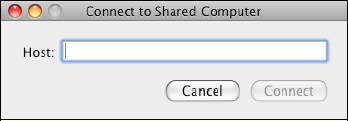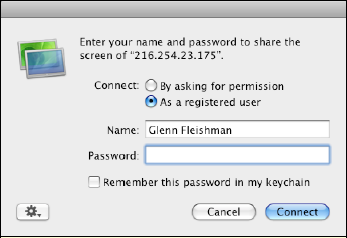The Screen Sharing program handles, well, screen sharing, but typically you don't launch the program separately. (For iChat-based connections, iChat doesn't even use the program directly, but employs components that the program uses.) Leopard handles the launch and connection for you. But if you want to connect directly to a remote IP address or host name, the program lets you do just that. And, if you've followed the directions in Turn on Bonjour Viewing, in the next section, you may prefer to launch it directly.
The Screen Sharing application is hidden in /System/Library/CoreServices. Apple hardly went out of its way to let you know
where it is, but there's no problem with actually running it.
Tip
If you're going to use the Screen Sharing application on its own frequently, make a shortcut of some kind to access it again. You can do any or all of the following:
Make an alias of Screen Sharing by holding down Command-Option while dragging its icon and dropping it on the Desktop or into another folder.
Drag the program's icon to the sidebar of a Finder window or select the icon in the Finder and choose File > Add to Sidebar; either method makes the program available via the sidebar of all Finder windows.
Drag the program's icon onto the Dock.
For the simplest use of Screen Sharing in its default configuration, where you plan to make a direct connection to a remote computer by entering an IP address or a host name, follow these steps:
Launch Screen Sharing.
In the Connect to Shared Computer dialog, enter the IP address or host name, and click Connect (Figure 6-1).
If you haven't stored a password for this system, a login dialog appears (Figure 6-2). Enter your credentials, and optionally choose to store the password in a keychain. Click Connect.
When a remote system is being controlled, a Screen Sharing status menu appears on the menu bar (A Screen Sharing Menu Appears in the System Menu Bar on a Remotely Controlled Computer, from Which You Can Terminate the Session).


